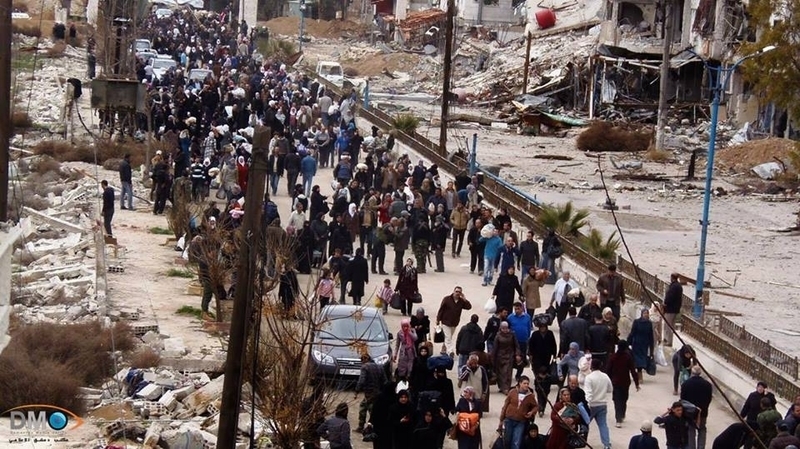Forcing besieged areas to comply with truce
The regime was using a range of persuasion and intimidation policies to force these areas to comply with its conditions, while military airplanes threw explosive barrels on Aleppo, Daraa, Yabroud and another besieged cities.
The regime tried hard to conduct these truces using any possible means to confuse and combine the two concepts of "truce" and "reconciliation", whereby truces reflect temporary settlements, while reconciliation reflects a permanent solution.
The regime tried to give the impression of accomplishing progress in its relationship inside the country, accomplishing the victory, proving its superiority, overcoming all political opposition and extending control over previously lost areas.
The policy depends on a staretgy of offering temptations and sending delegations separately to the besieged areas in order to accept a partial lifting of their siege to allow the supply of some food and goods. The regime even took photographs of its flag on one of the buildings to prove it had taken control without any foreign interference.
Where are the truces being upheld?
Many truces started last November. They began in the cities of Qudsaya and al-Hameh in the northwest Damascus countryside, then later they extended to the cities of Moadamia, in the west, and Madaya, and the Yarmouk camp in southern Damascus. These were followed by declarations of reconciliations in Barzeh, in the central north of Damascus. Afterwards, they started to occur in Yalda, Babila, Beit Sahem, and Akraba in the south of the province.
The regime announced similar reconciliations in Hajar al-Aswad, Tadamon, Al-Qadam and Daraya and attempted to achieve truces in Douma, the center of eastern Gouta, and in Zabadani, in western Ghouta in order to close all fronts to Damascus.
The city of Homs saw truces maintained for several days around the Old City and Waer areas. A truce was held in the city of Quneitera, in the Golan, and in Khan Arnabeh, Trnjeh and Jabata.
State of the truces
Babila
A child was killed and eight people wounded after Assad forces opened fire on crowds in a new violation of the truce there. Regime forces opened fire again on 27 March on crowds gathered around a military checkpoint. Some people are still trying to return to check their homes, while many are also trying to escape from the besieged city. It should be noted that the terms of this truce consisted of giving civilians complete freedom of movement in and out the area. It never happened.
Harasta
Soliman Salaas, the deputy mayor of Harasta city and one of the godfathers of the truce agreement in the city was assisinated. His body was found on Wednesday morning with two bullets to his head, after negotiations between the regime and rebels of the liberated city. This led to the truce on the western side of the city.
Pressure to comply with the term continues on the rest of the city and it is divided between supporters and non-supporters. All lack confidence that the regime will uphold the truce.
Features and backgrounds:
Some describe the truces as new maneuvers in order to pressure civilians, politicians, and the Free Syrian Army to regain regime control on besieged areas after blocking, starving, and killing people inside for more than one year.
The FSA is facing tough conditions to accept and comply with the truces for teo reasons: The regime has completely closed the areas and is still bombing them, while the civilians inside are exhausted from hunger.
Some civilians who agree to the truces say that the FSA failed to protect them. They are trapped between Assad's explosive barrels and missiles on the one hand, and war lords inside on the other. Some argue that accepting the truce is a betrayal for all the martyrs and the revolution and say that accepting the truce would give the regime a new opportunity to control liberated areas.
What are the features and the guarantees?
The regime has dealt with these truces in cities, towns and villages separately, preventing them from making a unified decision. The policy of offering relief is being used in smaller areas in order to weaken the larger ones.
– Most of thenegotiations were confidential and verbal
– Red Crescent and the Red Cross were not included in these negotiations and agreements, neither as a guarantors or observers
– There was no specific timetable for any truce
– There was no mention of the parties that participated or signed any of the agreements
– The regime concentrated on media, taking photos for fake celebrations by its forces and anf the FSA. Many scandals have emerged proving the regime used its own forces posing as FSA members
......


